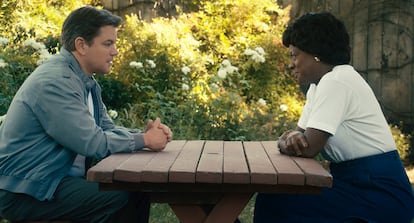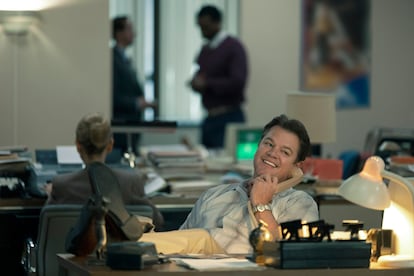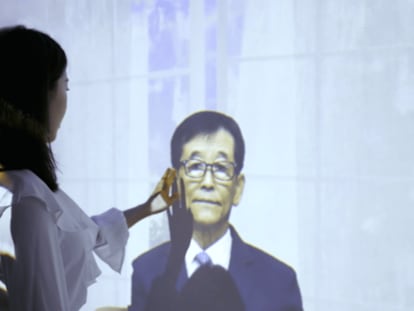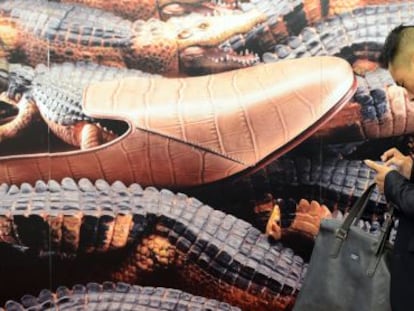The real story behind the iconic Air Jordans
This is the beginning in a long story that’s still being told after more than 30 pairs of shoes and billions of dollars in revenue

Matt Damon and Ben Affleck could go again as a team to the next Academy Awards. Both actors star in Air, a movie directed by Affleck, which tells the story of the iconic Air Jordan brand, one of the most popular shoes in the world. The film, penned by the unknown Alex Convery, has been critically acclaimed (at the moment it has 99% approval on RottenTomatoes) and it could become a spring hit, introducing to a massive audience to this unique story that changed the way we look at sports shoes.
The Oscar winners also produce the movie, which — interestingly — doesn’t include Michael Jordan, the central figure of the story who gave his name to the silhouettes. While he wasn’t involved in the production, he did meet with Affleck and gave several suggestions, including casting EGOT winner Viola Davis as his mother, Deloris Jordan. The rest of the story is based on different accounts of the Air project, with some elements added for dramatism. Let’s take a look at the real story behind it.

How were the Air Jordans born?
The Air Jordans’ story begins in the middle of the ‘80s, when Nike was looking to expand its brand into the basketball market. At the time, Nike was struggling to compete with other brands like Adidas and Converse, who were attracting young and sports oriented consumers.
John Paul “Sonny” Vaccaro (played by Matt Damon on Air) was a basketball promoter and marketing executive who had a close working relationship with Nike. He first got involved with the company in the early ‘80s when he helped sign several high-profile college basketball coaches to endorsement deals.
Vaccaro said he came up with the idea of collaborating with Michael Jordan after he saw his breakout performance at the 1984 Olympics in Los Angeles. He saw the potential he had to become a major basketball star and began working to secure an endorsement deal for him. For this, he approached several companies, including Nike, and introduced Jordan to them. The idea grew into creating a shoe brand with Jordan’s name on it. The player has credited David Falk, his agent, as the one that came up with the concept for the shoes.
Philip Knight (played by Ben Affleck) was the co-founder and CEO of Nike, which was already a successful brand before the Air Jordans. He initially had some reservations about signing Jordan to an endorsement deal, because Nike had never before signed a rookie athlete to a major deal. But, after meeting the player he was convinced that he could help elevate Nike’s basketball brand. Of course, neither Knight nor Vaccaro expected Jordan to become one of the greatest basketball players of all time.
Jordan himself wasn’t convinced of the sponsorship, admitting that he agreed to meet the Nike team after his mom talked him into it.
Knight also played an important role in the development of the Air Jordan line. Once the idea for an endorsement grew into creating a signature shoe for Jordan, he invested heavily in the design and marketing of the product, backed up by Peter Moore (played by Matthew Maher in the film) was the Creative Director at Nike during this time, and he is credited as the creator of the original Air Jordan 1 silhouette. He also created logos for the brands including the Air Jordan ball-and-wings logo, and the now iconic Jumpman logo.
Moore drew inspiration from several sources when designing the Air Jordan, with the main influence being Michael Jordan himself. For him, the shoe had to reflect the player’s unique style and personality.
He also took inspiration from the Nike Dunk and the Converse Chuck Taylor All Star, which was increasingly popular at the time. He combined elements of these shoes with his own version of high-end Italian fashion (influenced by Gucci and Prada), incorporating premium leather, creating a shoe silhouette that was both stylish and functional.
The shoe was released in 1985, and it quickly became a sensation, on par with Michael Jordan’s rise as one of the most valuable players in the league. He wore the shoes on court, making his fans wish they could wear the same pair.
The NBA ban
Something unexpected happened. The NBA banned the Air Jordan, because of the color scheme, which violated the league’s uniform policy at the time. The red and black colorway did not match the Chicago Bulls’ official team colors of red, white and black. The NBA’s policy stated that all players wear shoes that matched their team’s official colors.
Despite this ban, Jordan kept wearing the shoes during games, and Nike took advantage of the controversy in its marketing campaigns. He was never fined. In the middle of the 1985-1986 season the league changed its rules to allow Jordan to wear the shoes on the court, as long as he wore black or white shoelaces. This also influenced the popularity of the product.
The Air Jordan III
First released in 1988, the Air Jordan III is one of the most iconic shoes in the Air Jordan line. It was designed by Tinker Hatfield (who also created the next 12 versions of the show). The Air Jordan III was a departure from the previous two models in the series, and it introduced several new design elements that have since become hallmarks of the Air Jordan brand, like the use of visible air cushioning in the sole, a new mid-cut design and a unique lace-up system that helped improve stability and control when wearing them.
This was also the first Air Jordans that included the Jumpman logo, which features the silhouette of Michael Jordan jumping in midair, one of the most recognizable elements.
The marketing campaign for this release was also a success, thanks in part to Spike Lee’s involvement. The revolutionary filmmaker was a cultural icon and a fan of Michael Jordan, so he approached Nike with the idea of a series of commercials featuring the player.
The resulting campaign, known as “It’s Gotta Be the Shoes,” featured Jordan and Lee in a series of humorous and iconic advertisements that helped to establish the Air Jordans as a cultural phenomenon. Lee’s influence on the Air Jordans went beyond just the commercials, however. He also helped to design the Air Jordan III, providing input on the design of the shoe and helped to create the elephant print pattern that became one of the shoe’s defining features.
This, of course, was just the beginning in a long story that’s still being told after more than 30 releases and billions of dollars in revenue. According to Forbes, as of 2021, the Air Jordan brand is valued at over $2.1 billion, and it generates more than $3 billion in annual revenue. This makes it one of the most successful and profitable sneaker brands in the world.
Sign up for our weekly newsletter to get more English-language news coverage from EL PAÍS USA Edition
Tu suscripción se está usando en otro dispositivo
¿Quieres añadir otro usuario a tu suscripción?
Si continúas leyendo en este dispositivo, no se podrá leer en el otro.
FlechaTu suscripción se está usando en otro dispositivo y solo puedes acceder a EL PAÍS desde un dispositivo a la vez.
Si quieres compartir tu cuenta, cambia tu suscripción a la modalidad Premium, así podrás añadir otro usuario. Cada uno accederá con su propia cuenta de email, lo que os permitirá personalizar vuestra experiencia en EL PAÍS.
¿Tienes una suscripción de empresa? Accede aquí para contratar más cuentas.
En el caso de no saber quién está usando tu cuenta, te recomendamos cambiar tu contraseña aquí.
Si decides continuar compartiendo tu cuenta, este mensaje se mostrará en tu dispositivo y en el de la otra persona que está usando tu cuenta de forma indefinida, afectando a tu experiencia de lectura. Puedes consultar aquí los términos y condiciones de la suscripción digital.
More information
Archived In
Últimas noticias
The new victims of the Republican war on Obamacare: Millions hit by soaring health insurance premiums
A country divided on migrant rights: Some US states expand protections while others restrict them
Venezuela authorizes the release of another 87 political prisoners
There is as much life left to discover on planet Earth as that which is already known
Most viewed
- David King, chemist: ‘There are scientists studying how to cool the planet; nobody should stop these experiments from happening’
- Reinhard Genzel, Nobel laureate in physics: ‘One-minute videos will never give you the truth’
- Oona Chaplin: ‘I told James Cameron that I was living in a treehouse and starting a permaculture project with a friend’
- Sinaloa Cartel war is taking its toll on Los Chapitos
- The Interoceanic Train, the Mexican alternative to the Panama Canal











































